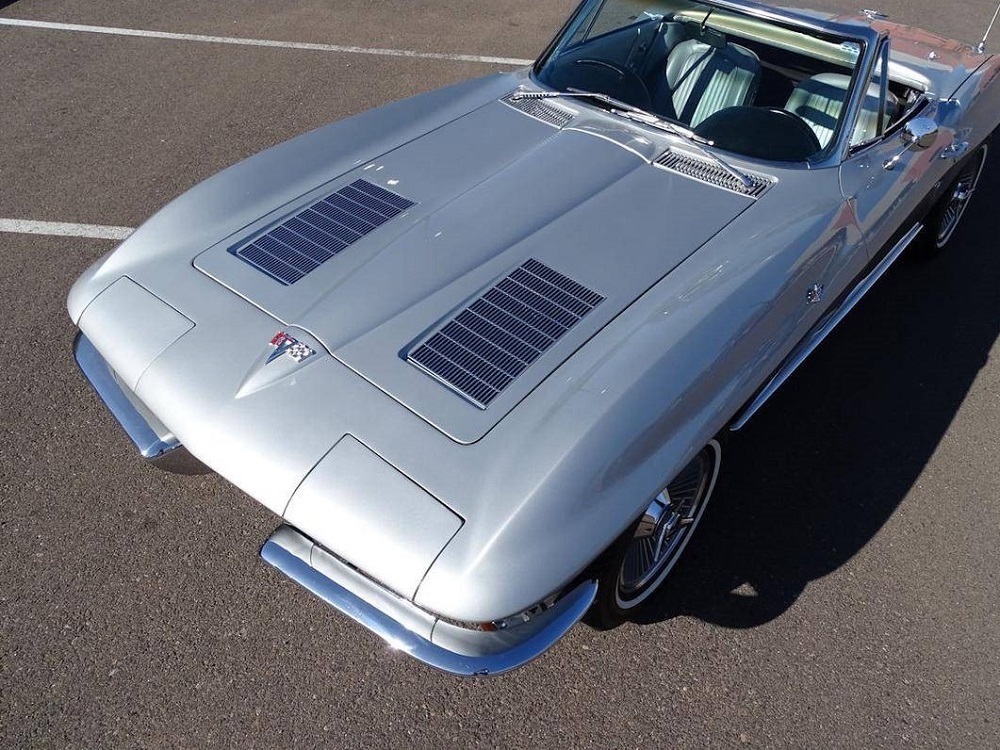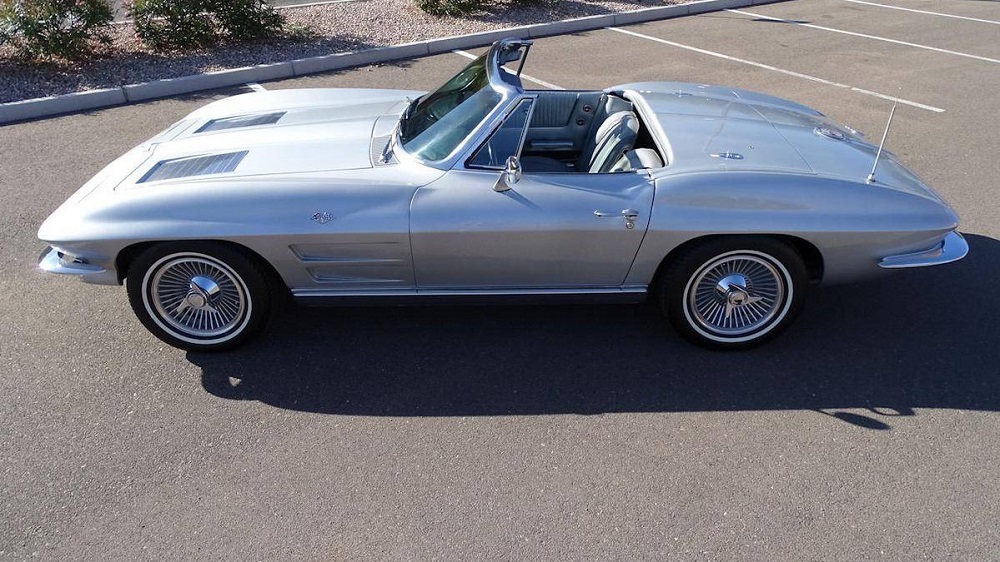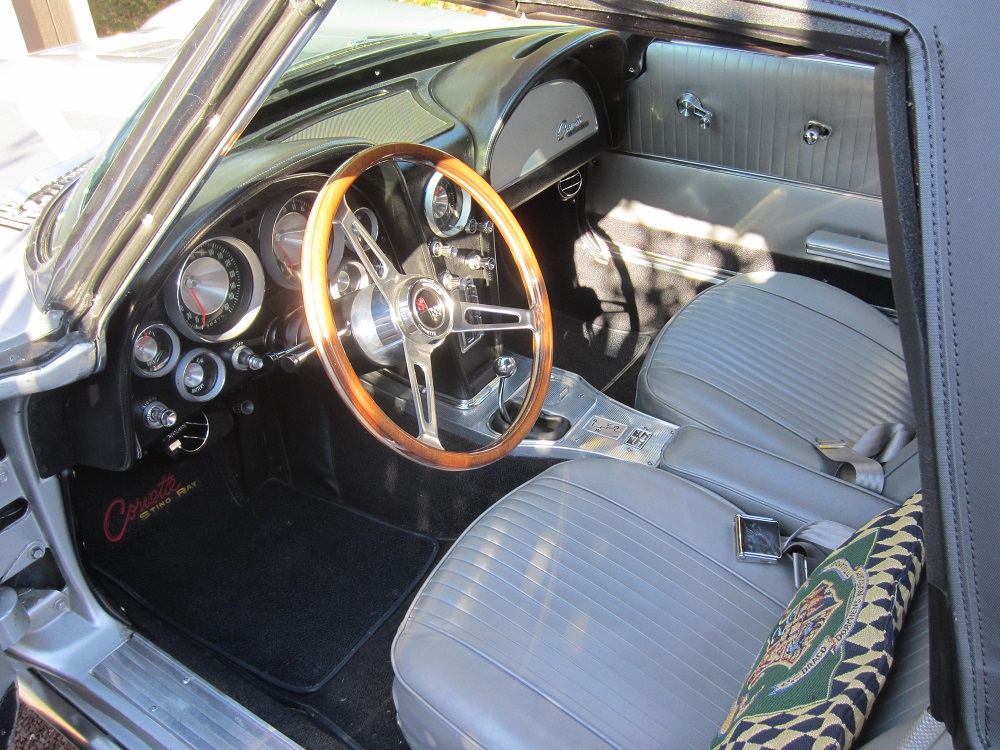After taking a week off for the holiday, we bring you Frank and his gorgeous 63 Corvette. Fan Car Friday is a segment where we want to share with the world the automobiles that our fans have. We have absolutely no affiliation/relationship with the cars, the build or the owners. This post was made with written consent from the owner.

“It was totally an impulse buy. Im a MOPAR guy but when I saw this something hit me. It’s just a gorgeous car that I can stare at for hours. I love the C2 style and those fake hood vents. For me those vents really set the 63 apart from all other C2s. I also believe there is more bright work on the 63 but I’m not sure about that. Ive had the car since last April.
The car was in AZ and Im in NJ. I saw it on Hemmings and fell in love, so I sent someone out to review her and ultimately made the purchase thru a third party broker. The car was sold as a mostly original example with a period correct 327 under the hood. I literally knew nothing about them. She isnt without wear and tear and the paint job while not Earl Scheib, is not show quality either. When I received it, I had a local guy that works on old cars put it up on a lift and check it out. It looked as clean as the pics. I had him put in a power boost system for the drum brakes and add a tilt wheel so I could get in and out. He messed up both….but finally got it right….he is no Phantom Works. I will have to find a mechanic that knows C2s.

There were a ton of invoices in the glove box through which I was able to track down and call the prior owner. He no longer drives and owned the car for the past 15 years. He told me as far as he knew (and his memory is sketchy) the car is original with the exception of a repaint in the original color (Sebring Silver) and a change over from a blue to silver interior which it had when he purchased it. He also said that the engine and 2 speed powerglide are original to the car. Lastly he stated that the owner before him is deceased so there the story seems to end.
I checked the engine block and the numbers match the VIN plate. So that’s interesting. It seems the car was made in July of 63, the engine in June of the same year. I haven’t had it back on a lift to check the trans. The exterior was Sebring Silver and the interior was blue. No way to know what color the top was. When I received the car it had a battered white top which I had to replace and I went with black.
She runs great but likes to run hot. It “puked” in my garage once at about 210 degrees on a 94 degree NJ summer day. I refilled it and replaced the battered overflow cap. I guess maybe the thermostat is next on my list. It hasn’t happened since but now I watch the gauge like a hawk. The radiator was repaired in 2010 according to those receipts I found and the gauge was replaced at that time. The car only has about 400 miles on it since then. It has an aftermarket Vintage AC unit in it from 2003. Even the “new” stuff in the car is old lol. Everything works except the clock.” – Frank D.

The 1963 Corvette Sting Ray not only had a new design, but also newfound handling prowess. The Sting Ray was also a somewhat lighter Corvette, so acceleration improved despite unchanged horsepower. For the 1963 model year, 21,513 units would be built, which was up 50 percent from the record-setting 1962 version. Production was divided almost evenly between the convertible and the new coupe – 10,919 and 10,594, respectively – and more than half the convertibles were ordered with the optional lift-off hardtop. Nevertheless, the coupe wouldn’t sell as well again throughout the Sting Ray years. In fact, not until 1969 (by which time the coupe came with removable T-tops) did the closed Corvette sell better than the open one. Equipment installations for 1963 began reflecting the market’s demand for more civility in sporting cars. The power brake option went into 15 percent of production, power steering into 12 percent. On the other hand, only 278 buyers specified the $421.80 air conditioning; leather upholstery – a mere $80.70 – was ordered on only 1,114 cars. The cast aluminum knock-off wheels, manufactured for Chevy by Kelsey-Hayes, cost $322.80 a set, but few buyers checked off that option. However, almost 18,000 Sting Rays left St. Louis with the four-speed manual gearbox – better than four out of every five.
All 1963 cars had 327cid engines, which made 250 hp standard, with optional variants that made 300 hp, 340 hp and 360 hp. The most powerful engine was the Rochester fuel injected engine. Options available on the C2 included AM-FM radio (mid 1963), air conditioning, and leather upholstery. Also available for the first time ever on a Corvette was a special performance equipment package the RPO Z-06, for $1,818.45. These Corvettes came to be known as the “Big Tanks” because the package initially had a 36.5-US-gallon (138 l; 30.4 imp gal) gas tank versus the standard 20-gallon for races such as Sebring and Daytona. At first, the package was only available on coupes because the oversized tank would not fit in the convertible.
In 1963 only 199 Z-06 Corvettes were produced, usually reserved for racing, and of the 199 a total of six were specifically created for Le Mans racing by Chevrolet. One of the six 1963 Z-06 Sting Ray’s was built late in 1962 to race at Riverside on 13 October 1962. They were destined to compete in a different sort of race for sports cars, a NASCAR sanctioned event on the famous Daytona Oval, the Daytona 250 – American Challenge Cup. This meant the cars needed to be prepared to a different set of rules, the same as those for the big Grand National stock cars. The chassis was modified extensively and an experimental 427 cu in (7,000 cc) engine installed. The car was lightened in every way possible and weighed just over 2,800 lb (1,300 kg). Extra fuel was carried in a specially fabricated tank occupying the area behind the driver. Driven by Junior Johnson, plagued by rain in the race, substitute driver Billy Krause finished third behind Paul Goldsmith’s Pontiac Tempest and A. J. Foyt in another Corvette.
New for the 1963 model year was an optional electronic ignition, the breakerless magnetic pulse-triggered Delcotronic, first offered by Pontiac on some 1963 models.

Want your car to be featured as one of our Fan Car Friday’s post? Know somebody that might? Use the contact link at the bottom and email us a couple of photos as well as your contact information and your vehicle could be featured on an upcoming Friday post. Please make sure to put FAN CAR in the subject heading.
Beautiful work !!!! Excellent
What a beautiful car. Love it.
wish i had one
Gorgeous car, great job cleaning it up – the interior looks like new. LOVE the silver seats.